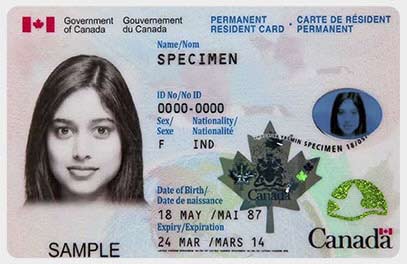
Canada's most acclaimed variety is not just beauty and culture, but also opportunities and amenities. Because of that, thousands and thousands of people migrate to Canada every single year. One of the questions that we get the most at our consultancy is, out of Canadian Permanent Residency VS Work Permit Visa, which visa should we choose? Let us analyze both these visas in detail here.
Canadian Permanent Residency VS Work Permit Visa
The concept of a Canadian Permanent Residence (PR) is a legal status that allows an immigrant to reside and earn a living anywhere in Canada legally. A work permit (WP) is a written authorization issued by an officer to work in Canada to a non-Canadian citizen or a permanent resident of Canada. Generally, this is only valid for a specific job, business or within a time frame.
Being a Canadian permanent resident means you can live and work in Canada with the same rights and privileges as a Canadian citizen. There is no need to search for a Canadian job offer and a new work permit. Moreover, your dependent family is also granted Canadian permanent residency rights, but this is not the case when dealing with temporary work permits. Some Canadian PNPs require applicants to declare their intention to reside in a particular province, like Manitoba, but they can live anywhere in Canada once the PR has granted.
Other benefits of Canadian PR include:
- Universal health care program(most of the medical expenses are covered), Canada
- Child Tax Benefit (Canadian government provides monthly tax-free payments which help to cover the costs for those families who have children under the age of 18)
- Free education(Children under 18)
- Old Age Security
- Guaranteed Income Supplement
- Canada Pension Plan(provide financial support to workers in their retirement age – currently age 65)
- Maternity and parental leave
- Social security (includes retirement payments, disability benefits, and survivors' benefits [for the survivors of deceased workers] etc.) and Canadian citizenship within three years.
The PR Card is usually issued for 5 years and can be renewed but can sometimes be issued for one year instead.
Canadian work permits (WP) are issued by Government officials in Canada, allowing target skilled foreigners to work for a Canadian employer/business. In all Provincial Nominee Programs (PNPs), work permits are issued to foreign investors who are experienced in entrepreneurship, business ownership and/or management, or even work experience applicable to the program of interest. In some cases, if the work permit holder applies for a permanent residency the person will not be granted permanent residency because of his/her work permit conditions. Temporary Workers Visa allows you to live & work in Canada for up to 4 years. However, you can apply for Canadian citizenship while working as a temporary worker in Canada.
The work permit holder's family can come to Canada with them. In some cases, spouses or common-law partners may be entitled to an open work permit. If the children of a temporary foreign worker want to study in Canada, they need a study permit.
Without a Temporary Residence Visa (TRV) or Electronic Travel Authorization (ETA), Permanent Residence holders can travel in and out of Canada, but Canadian Work Permit applicants may need a Temporary Resident Visa (TRV) to enter and/or re-enter Canada.
PR holders are not allowed to vote or run for political office and hold some jobs that need a high-level security clearance. To keep the PR status, he/she has been in Canada for at least 730 days during the last five years. The average time to obtain a Canadian PR is 18-24 months and to get a Canadian Work Permit depends on the programs but can take weeks to months depending on the additional requirements.
Between 13 Provincial Nominee Programs, 6 of them offer applicants Canadian permanent residency (PR) and seven programs offer a Canadian work permit (WP). Some PNPs require an investigative visit whereas others require an Expression of Interest or Entrepreneur Immigration Registration from Applicants. Anyhow all PNPs need an interview of the applicant.
There are various immigration programs for Canada Permanent Residency, but if you are a skilled worker express entry system is the best option.

5 main categories for Canadian Permanent Residence:
- Express Entry
- Provincial Nominee Programs
- Business Immigration
- Family Class Immigration
- Canadian Experience Class
Basic steps to apply for a Canada PR visa:
- The applicant needs to score 67 points based on age, education, work experience, language skills, adaptability, and the Canadian job offer.
- Complete Language Ability Tests & Educational Credential Assessment (ECA).
- Apply online through Express Entry, getting selected based on your ranking.
- After receiving the Invitation to Apply (ITA), make a final submission along with all required documents and relevant fees.
- The application will be reviewed by a Canadian immigration officer and will receive a confirmation of PR status.
- The final step is to apply for the PR card.
When the PR application is approved, the applicant will receive a passport request to be sent to the High Commission to attach your passport to an immigrant visa label. This is the PR visa, which is a single-entry visa and valid for 1 year. After arriving in Canada, the applicant must apply for an initial PR card as a newly landed immigrant.
There are 2 types of work permits;
- Employer-Specific work permit (According to some conditions like working for a specific employer, duration and location) .
- Openwork permit (work for any employer in Canada except for some employers listed as ineligible).
The basic steps for getting Canadian work permit:
- The employer applies for the Labor Market Impact Assessment or the Labor Market Impact Assessment Exemption, if necessary.
- Employer extends temporary employment offer.
- The foreign worker applies for the work permit.
- Work Permit issued.
There are some residency requirements for Canadian PR. To keep the PR status, he/she has been in Canada for at least 730 days during the last 5 years, which means the applicant can spend up to 3 years outside Canada during a period of 5 years.
After working in Canada with a work visa for 12 months under a NOC A, B, or O skill level job full-time, the applicant can apply for a Canada Permanent Residence through CEC (Canadian Experience Class) category.
If you are an eligible candidate and need any assistance in migrating to Canada, submit your details with us and let our Canada immigration consultants help you easily migrate to Canada.


